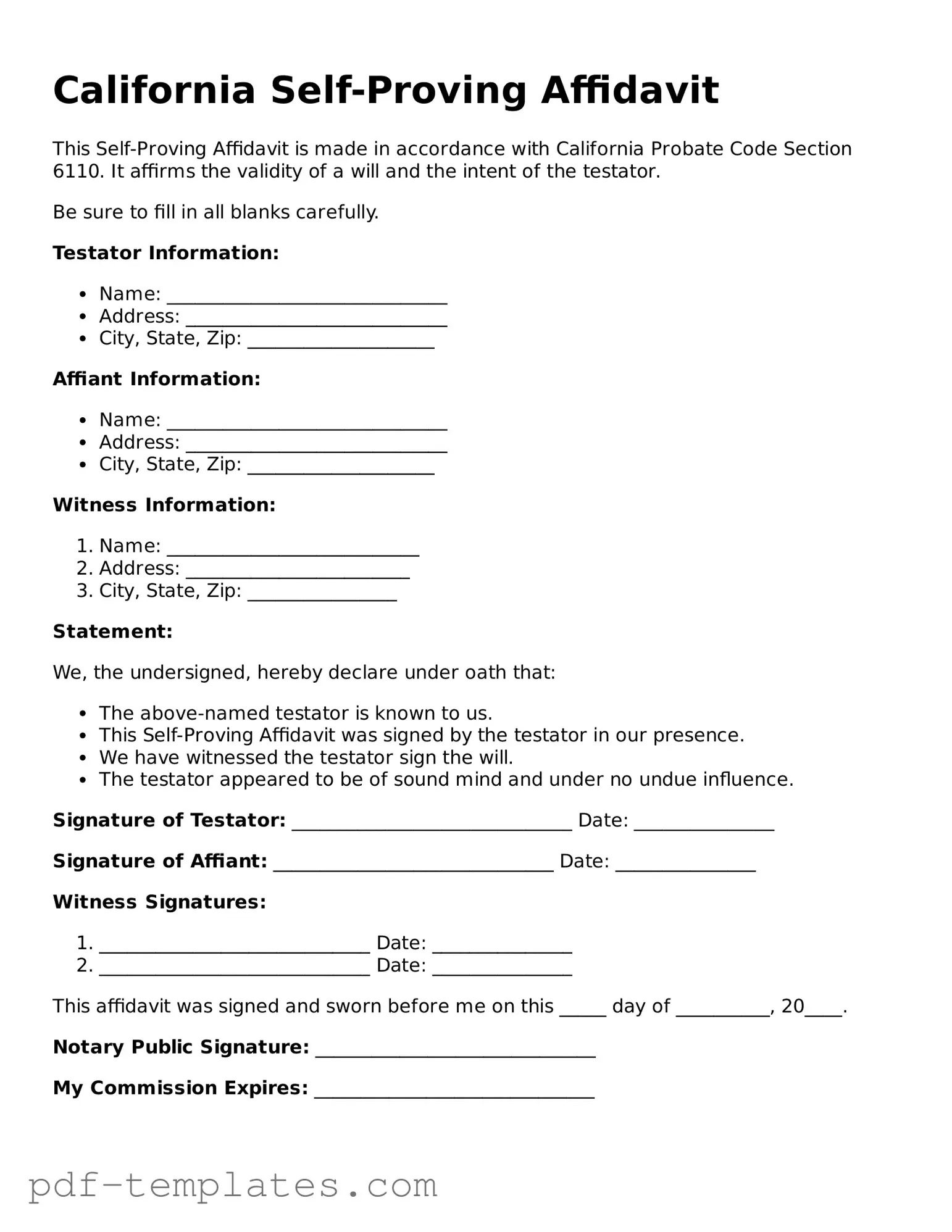The California Self-Proving Affidavit is similar to a Will, as both documents serve to express an individual's final wishes regarding the distribution of their assets after death. A Will outlines the testator's intentions and can be contested in court if not properly executed. The Self-Proving Affidavit, however, adds an extra layer of validity by allowing witnesses to affirm the testator’s signature and mental capacity, thereby streamlining the probate process and reducing the likelihood of disputes.
Another document akin to the Self-Proving Affidavit is a Durable Power of Attorney. This legal instrument grants a designated individual the authority to make decisions on behalf of another, particularly in health care or financial matters. Like the Self-Proving Affidavit, a Durable Power of Attorney requires the principal's clear intent and often necessitates witnesses or notarization to ensure its legitimacy. Both documents aim to protect the interests of the individual, whether in life or after death.
The Affidavit of Heirship is also comparable, as it is used to establish the heirs of a deceased person. This document is particularly useful when a decedent passes away without a Will. In a similar fashion to the Self-Proving Affidavit, it often requires the signatures of witnesses who can attest to the familial relationships and the decedent's intent. Both documents help clarify ownership and inheritance issues, minimizing confusion for surviving family members.
A Living Trust shares similarities with the Self-Proving Affidavit in that both aim to facilitate the transfer of assets and ensure the wishes of the individual are honored. A Living Trust allows for the management of assets during a person’s lifetime and can specify how assets are distributed upon death. While the Self-Proving Affidavit is a testamentary document, both serve to ease the process for heirs and beneficiaries, reducing the potential for legal complications.
The Advance Healthcare Directive is another document that parallels the Self-Proving Affidavit. It combines a living will and a Durable Power of Attorney for health care decisions. Both documents ensure that an individual's preferences regarding medical treatment are respected. The Advance Healthcare Directive, like the Self-Proving Affidavit, often requires witnesses to affirm the individual's wishes, thereby enhancing its legal standing and reducing ambiguity in critical situations.
The Quitclaim Deed is similar in that it is a legal document used to transfer property rights. While the Self-Proving Affidavit pertains to testamentary intent, a Quitclaim Deed allows for the transfer of property without guaranteeing that the grantor holds clear title. Both documents require careful execution and may involve witnesses or notarization to be legally binding, ensuring that the transfer is recognized and enforceable.
The Affidavit of Support, often used in immigration cases, bears resemblance to the Self-Proving Affidavit in that both require a sworn statement affirming certain facts. The Affidavit of Support demonstrates that an individual can financially support a foreign national. Similar to the Self-Proving Affidavit, it must be signed and often notarized, thereby providing a layer of assurance to the authorities regarding the claims made within the document.
For those interested in providing clear instructions regarding their healthcare preferences, the Texas Living Will form is an essential document. This tool allows individuals to outline their medical treatment choices, ensuring their values are respected. To learn more, visit this link for a comprehensive overview of the Living Will application.
Lastly, the Certificate of Trust is akin to the Self-Proving Affidavit as it provides evidence of the existence of a trust and the authority of the trustee. While the Self-Proving Affidavit confirms a person's final wishes, the Certificate of Trust serves to verify the legitimacy of the trust and its terms. Both documents are essential in clarifying intentions and facilitating the management of assets, making them crucial tools in estate planning.
